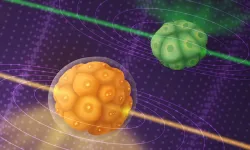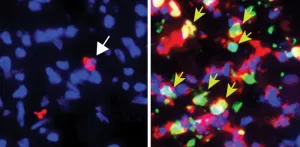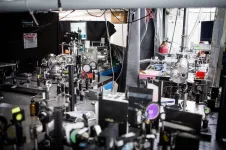(Press-News.org) Why do cancer immunotherapies work so extraordinarily well in a minority of patients, but fail in so many others? By analysing the role of neutrophils, immune cells whose presence usually signals treatment failure, scientists from the University of Geneva (UNIGE), from Harvard Medical School, and from Ludwig Cancer Center have discovered that there is not just one type of neutrophils, but several. Depending on certain markers on their surface, these cells can either promote the growth of tumours, or fight them and ensure the success of a treatment. By boosting the appropriate factors, neutrophils could become great agents of anti-tumour immunity and reinforce the effects of current immunotherapies. These results can be read in Cell.
Immunotherapy involves activating immune cells - mainly T cells - to recognise and destroy cancer cells. While this treatment is very efficient for some patients, and sometimes even exceeds expectations, it is unfortunately not the case in most cases. ‘‘The reasons for these failures remain largely unknown,” says Mikaël Pittet, full professor at the UNIGE Faculty of Medicine, holder of the ISREC chair in immuno-oncology, director of the Centre for Translational Research in Onco-Haematology and member of the Ludwig Cancer Center, who directed this work. “This is why deciphering the immune components involved is key to develop more advanced treatments and make immunotherapies a real therapeutic revolution.’’
Neutrophils are the most abundant immune cells in the blood and are very useful in infections or injuries by being quickly mobilised to the affected area and releasing antimicrobial factors. In the context of cancer, however, their presence is generally bad news as they promote vascularisation and tumour progression.
Not one but several types of neutrophils
To understand the exact role of neutrophils in cancer, the scientists observed what happened when mice with lung or colorectal cancer were given anti-tumour treatments. In tumours that responded well to treatments, the number of neutrophils increased significantly.
‘‘This first result was in contradiction with what was known about the role of neutrophils in cancer, pushing us to go further to understand why,’’ explains Allon Klein, associate professor of systems biology at Harvard Medical School, who co-directed this work. The Genevan and American scientists developed novel experimental protocols to compare successful and unsuccessful cancer treatments, then to analyse individual cells of interest in greater detail. ‘‘We discovered that neutrophils are in fact much more diverse than previously thought. Those we observe in response to immunotherapies are very different from those detected in progressing tumours and carry distinct markers. Furthermore, if we block the response of these particular neutrophils, the benefits of the treatment disappear.’’ These results are even more surprising as the treatments administered did not directly target neutrophils, uncovering a previously unknown indirect effect.
Therefore, neutrophils do not constitute a homogeneous population but can be pro- or anti-tumour depending on the circumstances. Moreover, anti-tumour neutrophils seem to share with neutrophils fighting bacterial infection or repairing wounds a strong cytotoxic power, i.e. the ability to destroy other cells. Their capacity of generating and releasing molecules right into a tumour could thus be of therapeutic interest.
Favouring the good over the bad
Neutrophils are produced in the bone marrow before circulating in the blood and tissues. ‘‘It seems that the fate of pro- or anti-tumour neutrophils is already determined in the bone marrow. Would it then be possible to manipulate them fight tumours? This what we now want to explore,’’ explains Mikaël Pittet. These promising results, which demonstrate that neutrophils can be mobilised to fight cancer, open the way to new therapeutic approaches that could make current immunotherapies much more effective.
END
Allies or enemies of cancer: the dual fate of neutrophils
An international team including scientists from the UNIGE and Harvard has discovered a new type of immune cell whose action is essential for the success of immunotherapies.
2023-03-30
ELSE PRESS RELEASES FROM THIS DATE:
Shining light on the mechanics of embryo development
2023-03-30
Summary
Scientists have come up with a new method to study the mechanical properties of developing embryos with unprecedented speed
The new method – line-scanning Brillouin microscopy (LSBM) – relies on a microscopy technique based on Brillouin scattering – a phenomenon where light interacts with naturally occurring thermal vibrations within materials.
The method, which can be used to non-invasively study developing embryos in three dimensions and across time, was selected as one of The Guardian's ...
Buprenorphine initiation in the ER found safe and effective for individuals with opioid use disorder who use fentanyl
2023-03-30
Buprenorphine initiation in the ER found safe and effective for individuals with opioid use disorder who use fentanyl
With historically high overdose death rates in U.S., multi-site NIH study reinforces importance of continued, uninterrupted access to addiction medication
Results from a multi-site clinical trial supported by the National Institutes of Health showed that less than 1% of people with opioid use disorder whose drug use includes fentanyl experienced withdrawal when starting buprenorphine in the ...
Severe hepatitis outbreak linked to common childhood viruses
2023-03-30
A new UC San Francisco-led study brings scientists closer to understanding the causes of a mysterious rash of cases of acute severe hepatitis that began appearing in otherwise healthy children after COVID-19 lockdowns eased in the United States and 34 other countries in the spring of 2022.
Pediatric hepatitis is rare, and doctors were alarmed when they started seeing outbreaks of severe unexplained hepatitis. There have been about 1,000 cases to date; 50 of these children needed liver transplants and at least 22 have died.
In the study, publishing on March 30 in Nature, researchers linked the disease to co-infections from multiple common viruses, in particular a strain of ...
New nanoparticles can perform gene-editing in the lungs
2023-03-30
CAMBRIDGE, MA -- Engineers at MIT and the University of Massachusetts Medical School have designed a new type of nanoparticle that can be administered to the lungs, where it can deliver messenger RNA encoding useful proteins.
With further development, these particles could offer an inhalable treatment for cystic fibrosis and other diseases of the lung, the researchers say.
“This is the first demonstration of highly efficient delivery of RNA to the lungs in mice. We are hopeful that it can be used to treat or repair ...
Racial disparities in pathological complete response among patients receiving neoadjuvant chemotherapy for early-stage breast cancer
2023-03-30
About The Study: In this study of 690 patients with early-stage breast cancer, racial disparities in response to neoadjuvant chemotherapy were associated with disparities in survival and varied across different breast cancer subtypes. This study highlights the potential benefits of better understanding the biology of primary and residual tumors.
Authors: Olufunmilayo I. Olopade, M.B.B.S., and Dezheng Huo, M.D., Ph.D., of the University of Chicago, are the corresponding authors.
To access the embargoed study: Visit our For The Media website at this link https://media.jamanetwork.com/
(doi:10.1001/jamanetworkopen.2023.3329)
Editor’s ...
Racial, ethnic, education differences in age of smoking initiation among young adults
2023-03-30
About The Study: Declines in smoking prevalence and increases in the age of smoking initiation occurred more slowly for young adults with less formal education, widening existing education disparities between 2002 and 2019. Black young adults had lower smoking prevalence and older age of smoking initiation than white young adults. However, declines in smoking prevalence and increases in the age of smoking initiation occurred more slowly for this group.
Authors: Alyssa F. Harlow, Ph.D., of the University of Southern California ...
Novel immunotherapy delivery approach safe and beneficial for some melanoma patients with leptomeningeal disease
2023-03-30
HOUSTON ― A novel approach to administer intrathecal (IT) immunotherapy (directly into the spinal fluid) and intravenous (IV) immunotherapy was safe and improved survival in a subset of patients with leptomeningeal disease (LMD) from metastatic melanoma, according to interim analyses of a Phase I/Ib trial led by researchers at The University of Texas MD Anderson Cancer Center.
The study, published today in Nature Medicine, represents the first-in-human trial of concurrent IT and IV nivolumab (anti-PD-1) in melanoma patients ...
Surprise finding shows that neutrophils can be key antitumor weapons
2023-03-30
White blood cells called neutrophils have an unappreciated role in eradicating solid tumors, according to a surprise discovery from a team led by Weill Cornell Medicine scientists.
In the study, published March 30 in Cell, the researchers investigated how a T cell-based immunotherapy was able to destroy melanoma tumors even though many of the tumor cells lacked the markers or “antigens” targeted by the T cells. They found that the T cells, in attacking the tumors, activated a swarm of neutrophils—which in turn killed the tumor cells that the T cells couldn’t ...
Monitoring chronic disease burden: EHRs can help meet a serious public health challenge
2023-03-30
INDIANAPOLIS – The pandemic has highlighted the importance of increasing the flow of information on infectious diseases from electronic health records (EHRs) to public health agencies. Less attention has been paid to the value of EHR data for chronic disease surveillance.
At the HIMSS (Healthcare Information and Management Systems Society) Global Health Conference & Exhibition (HIMSS23), Brian Dixon, PhD, MPA, of Regenstrief Institute and Indiana University Richard M. Fairbanks School of Public Health and Lorna Thorpe, PhD, MPH, of NYU Grossman School of Medicine, will ...
Exploiting dark autoionizing states for enhancing the extreme ultraviolet laser power
2023-03-30
Exploiting dark autoionizing states for enhancing the extreme ultraviolet laser power
A research team unravels a new optical phenomenon involving dark autoionizing states, enhancing the power of an extreme-ultraviolet laser.
An international research team led by Professors Tsuneyuki Ozaki and François Légaré at the Institut national de la recherche scientifique (INRS), has developed a unique method to enhance the power of a laser source emitting extreme ultraviolet light pulses. The underlying mechanism of the newly observed phenomenon involves the ...
LAST 30 PRESS RELEASES:
Orthopedics can play critical role in identifying intimate partner violence
Worms as particle sweepers
Second spider-parasitic mite described in Brazil
January 2026 issues of APA journals feature new research on autism, pediatric anxiety, psychedelic therapy, suicide prevention and more
Private equity acquired more than 500 autism centers over the past decade, new study shows
New cervical cancer screening guidelines from the US Department of Health and Human Services
Estimated burden of COVID-19 illnesses, medical visits, hospitalizations, and deaths in the US from October 2022 to September 2024
Smartphone use during school hours by US youth
Food insecurity and adverse social conditions tied to increased risk of long COVID in children
Earliest, hottest galaxy cluster gas on record could change our cosmological models
Greenland’s Prudhoe Dome ice cap was completely gone only 7,000 years ago, first GreenDrill study finds
Scientific validity of blue zones longevity research confirmed
Injectable breast ‘implant’ offers alternative to traditional surgeries
Neuroscientists devise formulas to measure multilingualism
New prostate cancer trial seeks to reduce toxicity without sacrificing efficacy
Geometry shapes life
A CRISPR screen reveals many previously unrecognized genes required for brain development and a new neurodevelopmental disorder
Hot flush treatment has anti-breast cancer activity, study finds
Securing AI systems against growing cybersecurity threats
Longest observation of an active solar region
Why nail-biting, procrastination and other self-sabotaging behaviors are rooted in survival instincts
Regional variations in mechanical properties of porcine leptomeninges
Artificial empathy in therapy and healthcare: advancements in interpersonal interaction technologies
Why some brains switch gears more efficiently than others
UVA’s Jundong Li wins ICDM’S 2025 Tao Li Award for data mining, machine learning
UVA’s low-power, high-performance computer power player Mircea Stan earns National Academy of Inventors fellowship
Not playing by the rules: USU researcher explores filamentous algae dynamics in rivers
Do our body clocks influence our risk of dementia?
Anthropologists offer new evidence of bipedalism in long-debated fossil discovery
Safer receipt paper from wood
[Press-News.org] Allies or enemies of cancer: the dual fate of neutrophilsAn international team including scientists from the UNIGE and Harvard has discovered a new type of immune cell whose action is essential for the success of immunotherapies.



